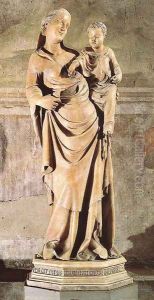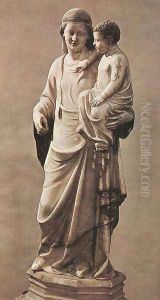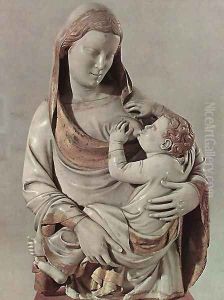Nino Pisano Paintings
Nino Pisano was an Italian sculptor of the 14th century, active during the period known as the Italian Renaissance. He was a member of the notable Pisano family of artists, which included his father, Andrea Pisano, one of the most prominent sculptors and architects of his time, and possibly his brother, Tommaso Pisano. The Pisano family played a significant role in the development of Italian sculpture and architecture during the 14th century.
Nino Pisano was likely born in Pisa, Italy, around the year 1315. His artistic style was heavily influenced by his father's work and the Gothic style prevalent during that period. He was known for his graceful figures and an emphasis on refined elegance and naturalism, which marked a departure from the more rigid and formalized figures of the earlier medieval period.
Nino's works are characterized by a softness of form and a gentle expressiveness. He worked on several important projects, including contributing to the decoration of the Camposanto Monumentale (the monumental cemetery) in Pisa, where his reliefs demonstrate his skill in creating flowing drapery and emotional facial expressions. Nino Pisano also contributed to the facade of the Santa Maria della Spina, a small church in Pisa known for its elaborate Gothic ornamentation.
One of Nino's most famous works is the 'Madonna with Child,' which showcases his ability to create tender and intimate religious scenes. His sculptures often reflected a deep understanding of human anatomy and movement, which was innovative for the time and would later influence the more naturalistic styles of the early Renaissance.
Nino Pisano's exact date of death is not known, but it is presumed to be around 1368. His contributions to sculpture set the stage for the later developments of the Renaissance and helped to bridge the gap between the Gothic style of the Middle Ages and the more naturalistic approach that would characterize the Renaissance. His legacy is somewhat overshadowed by that of his father and other contemporaries, but his work remains an important testament to the transitional period of Italian art.


